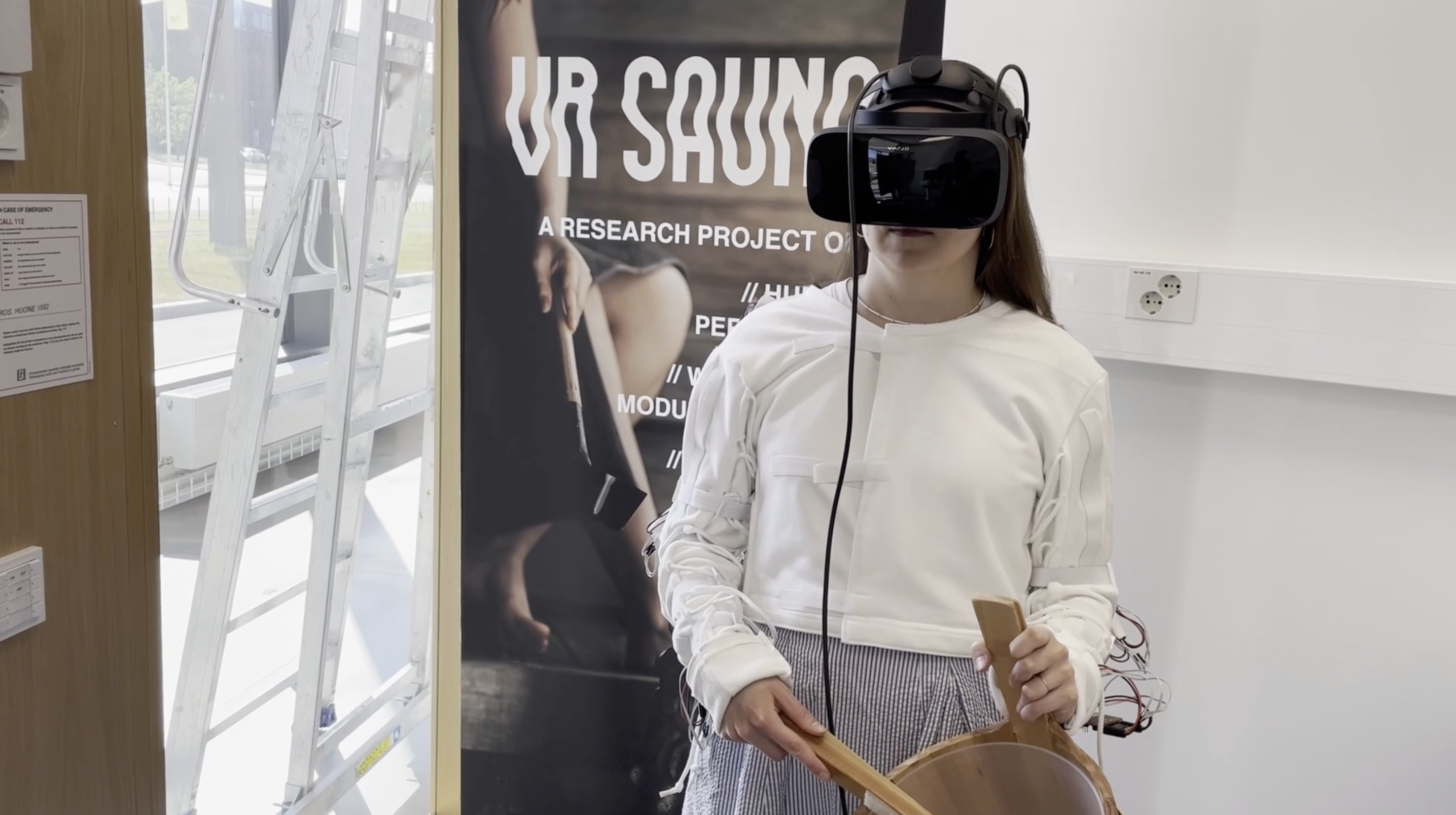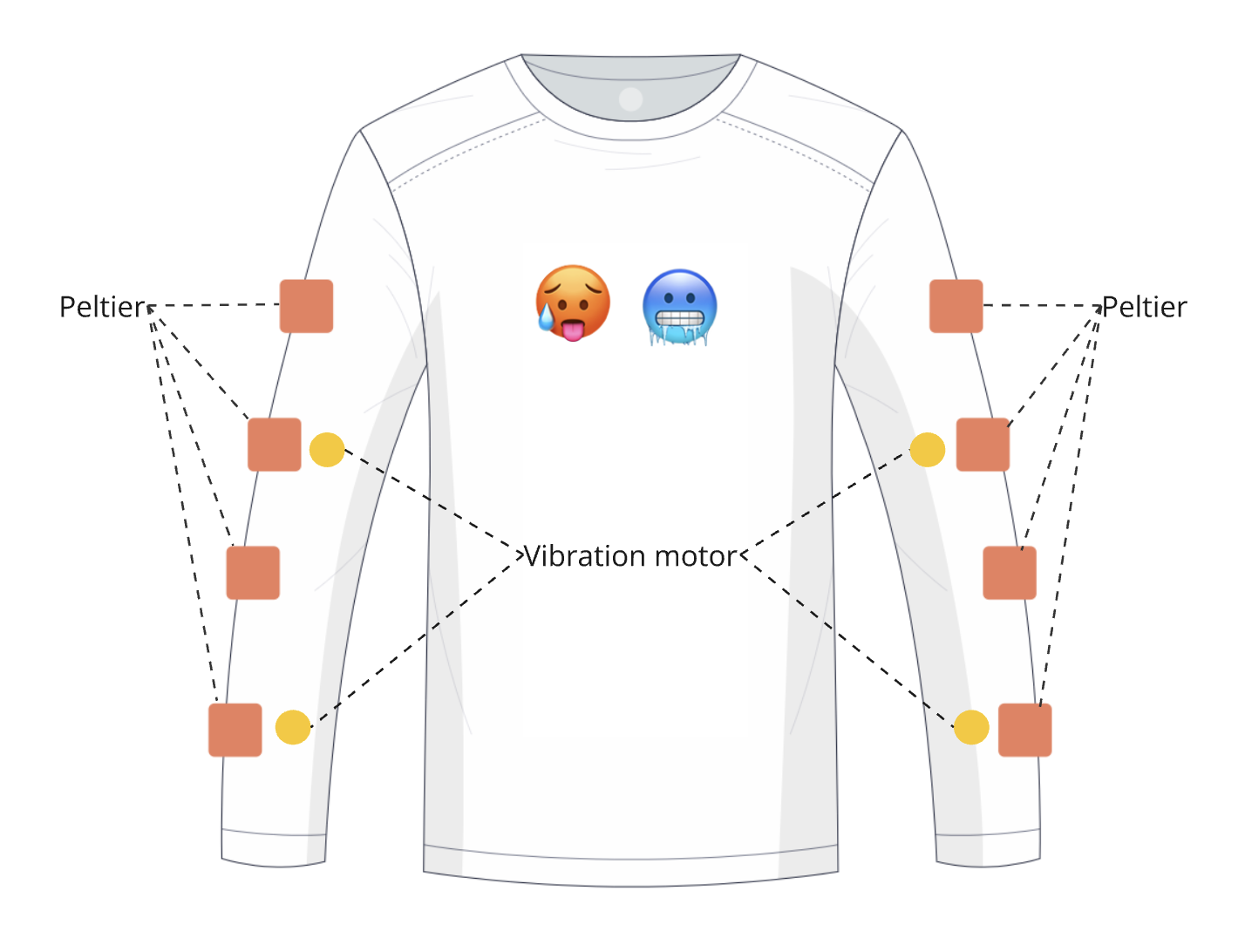Interaction Design x Research

Tim Moesgen is an interaction designer and doctoral researcher based at Aalto University in Finland. His research focuses on the design and development of haptic, thermal, and multi-sensory interfaces + experiences (e.g., in the contexts of VR, rehabilitation and well-being). With his research on such emerging technologies, he is also interested in advancing speculative methods + futures thinking to inspire the imagination and anticipation of inclusive and empathic futures.
With a background in research + design, Tim has collaborated in multidisciplinary contexts in Germany, the United States, and Finland.
With a background in research + design, Tim has collaborated in multidisciplinary contexts in Germany, the United States, and Finland.
︎ Key Interests: Thermal + Haptic Experiences ︎ Wearable Technology ︎ Embodied Interaction Design ︎ Virtual Reality ︎ Speculation + Futures Thinking
Projects
Designing Thermal Experiences for VR
Wearables, Thermal, VR






Haptic interfaces have been increasingly researched in the VR field. More and more companies release haptic gloves or suits that incorporate haptic feedback to stimulate the sense of touch. They make us feel the objects and scenes were are interacting with through vibrotactile or force feedback. However, thermal interfaces for VR are still under-researched.
But what if we could feel temperatures in VR? Imagine for instance VR fire-fighter training with the addition of heat feedback. Would that make the experience more realistic and more effective?
As part of the EU-funded project European Media and Immersion Lab (www.emil-xr.eu) we developed a wearable thermo-haptic interface that produces heat and cold with Peltier Elements and vibration feedback which can be coupled with game engines such as Unreal Engine. The system is modular and can be attached/de-attached from a washable under-garment and fits different body sizes. Through spatio-temporal control of the thermal and vibration modules dynamic feedback patterns can be designed that reproduce the sensation of traveling steam or a cold shower.
As the project was produced in Finland, we tested the system in a show-case experience of a traditional Finnish sauna experience that includes dynamic hot steam and cold shower.
The hardware design and code API is publicly available and re-usable under creative commons licensing here: https://drive.google.com/file/d/1jct_e0X0guGrw110XR_5dnaJEJwBXdSv/view
https://version.aalto.fi/gitlab/vikbere2/wearable-device-api
For demos please reach out to me via tim.moesgen@aalto.fi
But what if we could feel temperatures in VR? Imagine for instance VR fire-fighter training with the addition of heat feedback. Would that make the experience more realistic and more effective?
As part of the EU-funded project European Media and Immersion Lab (www.emil-xr.eu) we developed a wearable thermo-haptic interface that produces heat and cold with Peltier Elements and vibration feedback which can be coupled with game engines such as Unreal Engine. The system is modular and can be attached/de-attached from a washable under-garment and fits different body sizes. Through spatio-temporal control of the thermal and vibration modules dynamic feedback patterns can be designed that reproduce the sensation of traveling steam or a cold shower.
As the project was produced in Finland, we tested the system in a show-case experience of a traditional Finnish sauna experience that includes dynamic hot steam and cold shower.
The hardware design and code API is publicly available and re-usable under creative commons licensing here: https://drive.google.com/file/d/1jct_e0X0guGrw110XR_5dnaJEJwBXdSv/view
https://version.aalto.fi/gitlab/vikbere2/wearable-device-api
For demos please reach out to me via tim.moesgen@aalto.fi
Queer+Crip Body Mapping
Mapping, Chronic Pain, Thermal


Living with chronic joint pain in my hip for the past years has transformed my relationship with my body, making me more attuned to its needs and responses. This pain has led me to experiment with ways to manage my symptoms and better understand how my body responds to different stimuli. Samuels’ concept of “Crip time”—the process of “listening to the broken languages of our bodies, translating them, honoring their words” [63:3]—resonates with my journey of learning to navigate my pain. This journey inspired me to explore alternate forms of body mapping that might communicate my pain experience to others, including family, friends, and healthcare providers.
Living in a Nordic country, I have experienced firsthand how environmental temperature affects my joint pain. Cold winter temperatures amplify discomfort, making my joints and muscles feel tense and stiff, while heat provides relief, enhancing flexibility. Research supports the effects of temperature on osteoarthritis pain, highlighting how warmth can ease joint pain [53]. The Finnish sauna has become a significant ritual for me, providing therapeutic warmth that alleviates the harsh effects of winter. This practice led me to consider how temperature-based embodied mapping might capture and communicate my experiences with chronic pain [55].
To explore this idea, I recorded my own reflections before, during, and after weekly sauna sessions over the course of a month, documenting how my body responded to shifts in temperature, over time [75]. These recordings helped me identify which temperatures, movements, and sensations were most beneficial, fostering a deeper understanding of how heat affected my body. During this mapping process, I observed that pain is not solely a physical sensation; it is influenced by social and emotional contexts. Sauna sessions, especially those with friends, made me more aware of how pain becomes visible in social settings. When I stood up slowly or moved with visible discomfort, well-meaning friends often expressed concern. While these interactions were supportive, they also highlighted the visibility of my pain, making me feel at first self-conscious but after a while getting used to share my story when my friends asked about it. Pain thus became more than a personal experience; it became socially shared and shaped by the reactions of others around me.
My verbal reflections led me to document my experiences with heat visually through a spectrogram, or audio visualization, illustrating some of my collected audio data combined with experience trajectories and body visualizations to demonstrate how temperature and pain experience interact physically, emotionally and socially over time. I used the audio spectrogram as a visual means to show the entangled nature of my verbal expressions about my bodily and affective experiences based on sound data, heat and social interactions. I am expanding beyond soma trajectories proposed by Tennent et al. [75] by actively attuning to environmental factors, including the space I am in, its shifting temperatures, and the presence of people around me, while integrating these reflections into my visualization.
With this mapping exercise the heat from the sauna became a means of self-expression, allowing me to reflect on the shifts in my physical and emotional states through embodied mapping. My experience highlights how pain encompasses not just physical discomfort but also emotional and social facets that are deeply interconnected.
The temperature-based embodied mapping exercise underscores the need to recognize pain as a multifaceted experience that extends beyond quantifiable measures. Chronic pain, as I discovered, is entangled with personal, social, and psychological elements, making it challenging to capture in conventional body maps. This alternate approach emphasizes that pain is an evolving experience shaped by context, relationships, and emotions, factors that a traditional static body map might overlook.
Published in: ︎Alexandra Teixeira Riggs, Sylvia Janicki, Tim Moesgen, Noura Howell, Karen Anne Cochrane. 2025. Queer/Crip Body Mapping: Expressing Dynamic Bodily Experiences with Data. In Designing Interactive Systems Conference (DIS ’25), July 5–9, 2025, Madeira, Portugal. ACM, New York, NY, USA. (COMING SOON)
Living in a Nordic country, I have experienced firsthand how environmental temperature affects my joint pain. Cold winter temperatures amplify discomfort, making my joints and muscles feel tense and stiff, while heat provides relief, enhancing flexibility. Research supports the effects of temperature on osteoarthritis pain, highlighting how warmth can ease joint pain [53]. The Finnish sauna has become a significant ritual for me, providing therapeutic warmth that alleviates the harsh effects of winter. This practice led me to consider how temperature-based embodied mapping might capture and communicate my experiences with chronic pain [55].
To explore this idea, I recorded my own reflections before, during, and after weekly sauna sessions over the course of a month, documenting how my body responded to shifts in temperature, over time [75]. These recordings helped me identify which temperatures, movements, and sensations were most beneficial, fostering a deeper understanding of how heat affected my body. During this mapping process, I observed that pain is not solely a physical sensation; it is influenced by social and emotional contexts. Sauna sessions, especially those with friends, made me more aware of how pain becomes visible in social settings. When I stood up slowly or moved with visible discomfort, well-meaning friends often expressed concern. While these interactions were supportive, they also highlighted the visibility of my pain, making me feel at first self-conscious but after a while getting used to share my story when my friends asked about it. Pain thus became more than a personal experience; it became socially shared and shaped by the reactions of others around me.
My verbal reflections led me to document my experiences with heat visually through a spectrogram, or audio visualization, illustrating some of my collected audio data combined with experience trajectories and body visualizations to demonstrate how temperature and pain experience interact physically, emotionally and socially over time. I used the audio spectrogram as a visual means to show the entangled nature of my verbal expressions about my bodily and affective experiences based on sound data, heat and social interactions. I am expanding beyond soma trajectories proposed by Tennent et al. [75] by actively attuning to environmental factors, including the space I am in, its shifting temperatures, and the presence of people around me, while integrating these reflections into my visualization.
With this mapping exercise the heat from the sauna became a means of self-expression, allowing me to reflect on the shifts in my physical and emotional states through embodied mapping. My experience highlights how pain encompasses not just physical discomfort but also emotional and social facets that are deeply interconnected.
The temperature-based embodied mapping exercise underscores the need to recognize pain as a multifaceted experience that extends beyond quantifiable measures. Chronic pain, as I discovered, is entangled with personal, social, and psychological elements, making it challenging to capture in conventional body maps. This alternate approach emphasizes that pain is an evolving experience shaped by context, relationships, and emotions, factors that a traditional static body map might overlook.
Published in: ︎Alexandra Teixeira Riggs, Sylvia Janicki, Tim Moesgen, Noura Howell, Karen Anne Cochrane. 2025. Queer/Crip Body Mapping: Expressing Dynamic Bodily Experiences with Data. In Designing Interactive Systems Conference (DIS ’25), July 5–9, 2025, Madeira, Portugal. ACM, New York, NY, USA. (COMING SOON)